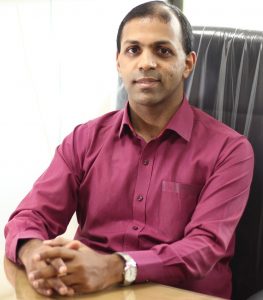
The patterning of liquids and soft materials has garnered a lot of attention in recent times because of its various application in fields like fabrication of organic electronics, microfluidics, tissue engineering/bio-engineering, optoelectronics, and so on.
Photoinduced dewetting is a technique that has been studied in much detail recently. The authors of this paper, which include Ms. Swathi Erekath and Prof. Sreeram K. Kalpathy from the Department of Metallurgical and Materials Engineering, Indian Institute of Technology Madras, Chennai, India, have also focused on this technique in this paper. In this technique, a film of photochemically responsive liquid or polymer resting on a solid substrate is first exposed to a certain wavelength of intense light beam to force local changes in the chemical structure of the film. This is useful either directly as templates for functional applications, or indirectly as templates for structuring other materials on micro- or nano-scales.
Photoinduced dewetting has 2 advantages over conventional lithographic processes:
1. This technique is reversible. The patterns formed by dewetting can be erased or altered upon exposure to radiation of a different wavelength, enabling the fabrication of rewriteable devices.
2. The use of light as the driving force simplifies the process greatly. Light is a clean and non-contact stimulus which can be switched on and off fast, thus avoiding the need for harsh environments or toxic solvents for enabling chemical reactions.
These advantages make this technique cost-effective and efficient especially in biological (cell and tissue engineering) and solar cell related applications.
This technique can also be useful in the patterning of polymers and soft materials used in the printed electronics industry. Thus this technique finds use in efficient patterning for the fabrication of organic light-emitting displays (OLEDs), displays, solar cells, sensors, and so on.
Although quite a few experimental studies have been reported on this technique in recent times, there are very limited theoretical and computational modelling studies to understand the interfacial transport phenomena associated with photochemical patterning process.


In this study, the authors of this paper attempt to describe the dynamics of the process through an interfacial hydrodynamic model that can unravel the physics and mechanisms responsible for the evolution of patterns.
Unlike the other models, where photochemically induced pattern evolution is described, the model used in this paper considers dynamical variation of the photoproduct concentration through first order chemical reaction kinetics.
The model used here pertains to a liquid or a polymer film in its flowing state. The model accounts for Marangoni flow which is the main flow phenomenon in this process. It describes the mass transfer along an interface between two fluids due to a gradient in surface tension.
Thus an interfacial hydrodynamic model was studied for efficient patterning. This study has many uses in the fields of electronics, biological systems, and sensors. The model presented here can be applied to more complex dynamics like higher order reaction kinetics. This study also stresses the importance of mathematical modelling for understanding and predicting processes occurring at micro- and submicron scales. The authors hope that the findings in this paper will help researchers to select the right choice of photoresponsive materials for patterning.
Prof. Sriharitha Rowthu from the Materials Engineering Department, Indian Institute of Technology Gandhinagar, Gujarat, India, praised the efforts of the authors by giving the following comments: “This journal article is excellent in providing the in-depth scientific understanding of the photochemical induced nano patterning process on the soft polymers/liquids by using a 2D hydrodynamic model. This process can be applied to azobenzene containing polymers, for example−polystyrene, a widely used industrial polymer for generating nano pillars and holes. A key insight from this work is the development of processing maps of feature width−Marangoni number and feature width−reaction rate coefficient for achieving ideal textures. This process can offer a cost-effective, recyclable, environmentally safe strategy to print polymers especially in the electronics, solar cells, and sensors applications. The simple nature of the light source enables easy up-scaling of the micro and nanotexturing to bigger devices and larger functional surfaces.”
Article by Akshay Anantharaman
Here is the original link to the paper:
https://www.sciencedirect.com/science/article/abs/pii/S0735193322001531?dgcid=author









